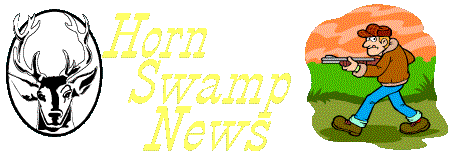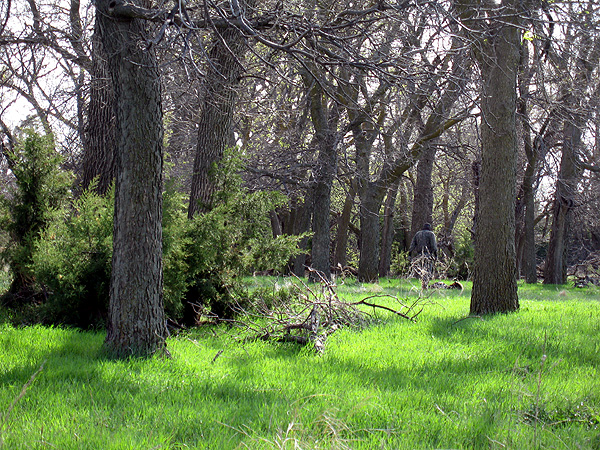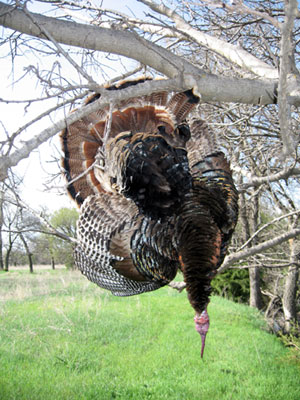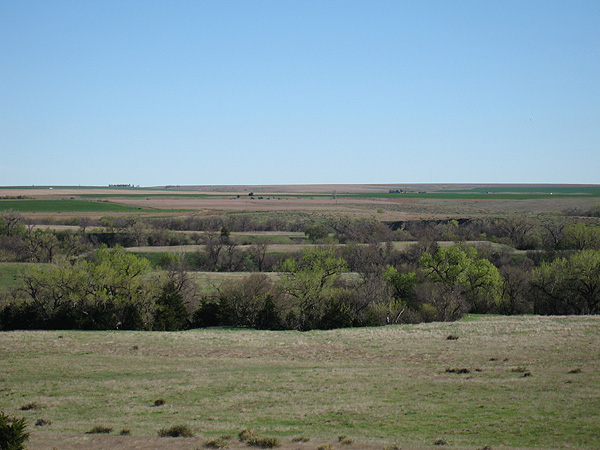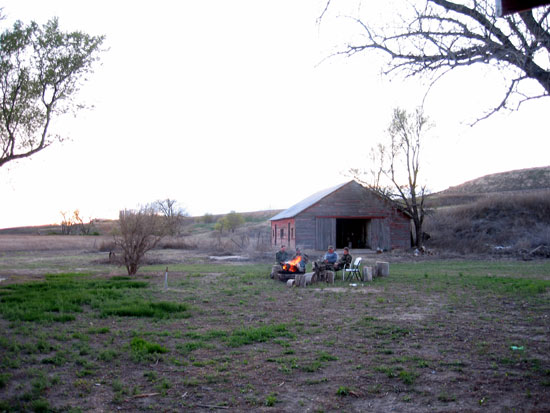SPECIAL FEATURE
NEBRASKA TURKEY HUNT
April 2010
In the spring of 2010 I was invited to a three day turkey hunt in Nebraska along with five other NWTF chapter volunteers and our regional director. The seven of us left Alabama on the morning of April 27th and drove all day, arriving in Wichita, Kansas just after midnight. After a little rest we drove the remaining five hours the next morning and arrived in Trenton, Nebraska at lunchtime on Wednesday.
Along on the trip was Mike Colquett from Monroeville (Alabama State NWTF President), Charlie Duckett from Selma, Vandy Collins from Faundale, Stephen Daniels from Mobile, Michael Bedwell from Jackson, and Chris Adams from Philadelphia, Mississippi who serves as our regional director with the NWTF. We were hunting with Kyle Nichols of Countree Outfitters (www.countryoutfittersandhunts.com), located between the towns of Trenton and Culbertson in the southwest portion of the state. We actually never went more than ten miles into Nebraska.
It was to be my first turkey hunt outside the state of Alabama. I was fired up about the opportunity to chase these birds that were a mix of the Rio Grande and the Merriam species of the wild turkey. Just the trip driving across the states of Oklahoma and Kansas had been an experience in itself and a first for me to see that part of this great country.
Our lodging for the hunt
After a quick lunch in the little town of Trenton, we arrived at the farmhouse where we would be staying and met with Kyle Nichols, the outfitter. Several of the guys with us had hunted with Kyle the prior spring and knew the properties we would be hunting. After getting our gear situated we quickly divided into pairs and struck out in search of turkeys.
I could not picture the habitat we would be hunting until I actually saw it. After having driven for miles and miles and miles across open farm land we finally came to a creek. Three of the areas we would hunt were alongside this creek which flowed into the Russian River. We also hunted alongside the river, which was about 20 feet wide. There were two kinds of trees in this part of Nebraska---cottonwood and cedar. The cottonwoods grew alongside the creek and river and provided roosting for the turkeys. The turkeys would fly down and move out into the open fields during the day. Some of the fields were larger than others and there were times when you could sneak reasonably close to birds out in the fields and other times when you could not get anywhere remotely close to them.
Big cottonwoods and cedars
Turkeys love to roost in big cottonwoods like this and big flocks
often use the same roosting spot each evening.
Charlie and I would hunt together for the first few hunts at a location they simply called "The Farm." We would park at an abandoned farmhouse (x) and walk south along the creek. The turkeys had their favorite roost sites and the one marked in the photo was their preferred one. The ground to the east and the west of the creek was a higher elevation, about 75 feet higher or more in some areas, with the creek seemingly having cut its way in the earth. The change in elevations aided us in moving on these birds since the lack of cover did not. Thankfully Charlie had hunted this property last season and knew the area and the tendency of the turkeys.
As we drove in that first day across Kansas a south wind of 35-40 mph gave us quite a challenge to stay on the road and it had not let up as Charlie and I walked down the hill from the farmhouse into the creek bottom. After my hat blew off a few times and I had to chase it down twenty yards or more away, I gave up and tucked it away in my vest. We proceeded south along the east side of the creek and were slipping along the edge of the small brown field in the photo when a hen that we had not seen spooked and ran from the adjoining field. We crept forward and I spotted a gobbler in full strut, across the creek (at the xx mark in the photo). He had two hens with him that we could see. We slipped into the creek and moved forward and then crawled out of the creek on the opposite side. Charlie raised up and the turkeys had moved a little farther out from the creek under some cottonwoods. A big cottonwood tree with some cedars provided the perfect cover for Charlie to crawl 30 yards closer to the turkeys. I would stay back and call if needed.
We first saw the bird across the creek, in full strut with two hens
Charlie crawled into position to the large cottonwood in the center of the photoCharlie reached the tree and stood up behind and it and saw the turkeys had moved off to what he thought was a little out of range. These wide open areas take some getting used to for those of us accustomed to hunting in thick woods. He watched the gobbler strut back and forth at what ended up being about 40 yards away. I yelped a few times and he answered twice. He seemed close to me and I wondered when Charlie was going to bust him. I can't say that I called the turkey closer, but the hens worked back toward us and the gobbler followed. When he was at 24 steps Charlie eased his gun around the tree and smoked him in full strut. Just two hours into the hunt I had seen the first turkey die. I thought this was going to be real easy.
Just after the shot, Charlie runs to the bird.
From the turkey's viewpoint. Charlie was behind the marked tree and had great
cover thanks to the cedars that were also alongside.
Charlie Duckett
We hung the bird in this tree and went in search of
another one for me.Charlie is your typical traditional Alabama turkey hunter. Like me, he prefers to kill turkeys that have been called. There was more "positioning" involved on this kill than "calling," however, we both agreed it was good to get one bird so quick into the hunt and at least take the pressure off of him at least. For me, the pressure was just beginning.
We headed south and crossed the creek at one of several cattle crossings cut in the steep bank of the creek. Across a field and across another crossing we were back on the west side of the creek and headed across a field when we spotted three strutters also in the field, but at a slightly lower elevation that had allowed us to walk within 100 yards of them undetected. We backtracked to the creek again and set up with our back to the creek in hopes they would come our way and roost at the favorite roosting spot located on the map. (Our location was at the xxx mark.)
There was a sharp drop off where the field met the creek that prevented you from being able to sit at a tree and see out into the field. It would be critical that if the gobblers did come out way that they come to the edge of the hill and look over and not just blow by a little ways out in the field. So we sat down and waited, calling each time the wind briefly calmed.
It was 35 yards to the crest of that hill and I hoped they would come over to my side.
The first action came when a hen arrived from behind us, pitched across the creek, and walked past me at five yards. She went out in front of us and soon we heard a gobble in the field, headed our way. A few minutes later I saw the head of gobbler just over the hill. At about 40 yards I could have taken a shot but I could not see the beard to know for sure if this was one of the mature gobblers or a jake. The turkeys were all still grouped together and the jakes were still hanging close to the gobblers. I did not want to shoot a jake .
This turkey walked more to my right and then it and another of the gobblers walked far enough over the hill to come into plain view. Unfortunately they were now too far to my right for a clear shot. I had a huge dead limb from a cottonwood lying on the ground and blocking my opportunity for a clear shot. I did all the maneuvering I could to get a shot but it did not happen. They looked and looked for the hens they heard but finally walked over the hill and headed for their roost. Charlie and I waited a bit and then headed for the higher ground to watch the turkeys go to roost.
The turkeys are tiny specks in the edge of the cottonwoods below us.
One of their favorite roosts was located in the dead center of this photo.
Looking back in the other direction off the same hill, the gobblers were first spotted in the pasture
to the far left in the photo. You can see the small changes in elevation that helped conceal us initially.
In hindsight I should have taken that first shot at the gobbler. It was reasonable to conclude that he was a gobbler and not a jake, though I could not be certain. For the next two days I would regret not having taken the chance.
The next morning we returned and I got back in the creek bottom close to my location the prior afternoon. Thankfully the wind had calmed and it would not be a big factor the remainder fo the hunting trip. Charlie sat across the field and on the hill overlooking the bottom. We expected they would head back toward an alfalfa field and would use the easiest route possible to get there. Should they come across the hill Charlie would be in position and if through the bottom they would come near me. Just like turkeys will do, this time they flew down on the northern side of the creek from the "roost" location. After a hour or so I rejoined Charlie on the high ground and we watched the flock work their way through the field on the other side of the creek. We then sneaked down the hill and I eventually crawled down the creek bank and across the creek to the other side and almost made it in time to cut off three of the gobblers. I was not quite fast enough though and they pitched across the creek, walked up a very steep embankment and then went across the hillside and back down to the lower ground and the alfalfa field on the other side. It was a very unlikely route they took. I would have bet my gun that they would not have taken the most difficult route to the alfalfa but they did. Our hunt was over for the morning.
A view from the hill, the turkeys are in the pasture in the center of the photo.
I crawled down the hill into the creek and almost cut them them off as they moved
right to left.
You can see the dark specks of gobblers in the field. At one time there were a dozen gobblers in the
field. The woods on the other side of the field would have provided a great spot to hunt the birds
but they were across the property line.
One of the creek crossings, used by the cattle on the property.In the afternoon I returned to the farm alone and went right back to the cattle crossing where I hunted on the two prior hunts. The outfitter, Kyle, suggested that I go there as the turkeys often used this location to cross the creek while returning to the roost from some distant canyons where they often spent their days. The afternoon started sunny and warm and I had worked up quite a sweat by the time I reached the crossing. I could see clouds building in the west and knew the chance of rain that had been forecasted was about to materialize. The wind picked up and the temperature dropped quickly. It was not long before I was shivering and wishing I had brought a jacket. Finally when the rain did arrive it was just a light drizzle and the wind stopped. I actually warmed up at that point.
The turkeys again fooled me as they took a different route to the roost tree, though I'm not sure exactly which route they took. What I do know is that an hour or so before dark, a little early due to the rain, I began seeing them fly up into the big cottonwoods. I left a little early and got back to the truck before I was completely soaked.The next morning Michael Bedwell and I hunted the other side of this property. Michael and Stephen Daniels had hunted this section, which was just down the creek from us and had both killed their two bird limit by the end of the third hunt. They made quick work of the Nebraska birds.
The ground on that side of the farm was very similar but there were some areas that made it easier to sneak closer to the turkeys than on our side. I hoped we would have similar success and was glad to have Michael pointing the way as he already knew the lay of the land. We heard only one turkey gobble to begin the morning and he was a good ways up the creek from us. We sat and waited for any turkeys in our area to fly down. Moving around in this open ground is tough while the birds are still on the roost. We moved forward a few bends in the creek and sat down and eventually spotted one gobbler strut over a hillside and then disappear back to the other side. We never knew which way he went. We heard one more turkey gobble towards the back side of the property and began moving his way. Apparently he was headed south, over a big hillside and toward the canyons past the property line. After a long walk to the back corner of the farm I finally spotted this gobbler and a few hens but they were too far gone for a successful attempt to call them back our way.
A view from the back of the property looking north, looking over the winding creek bed and cottonwoods
that held the turkeys. We began the hunt this morning one and a half miles to the north.
Looking west from the south side of the property, you can see the farmhouse on the other side
of the farm where we parked the first few days of hunting. We saw a good many deer ducking
in and out of these cedars on this morning and also a coyote or two.We gathered back at the farmhouse at lunch. Mike killed his first bird that morning which gave every hunter but me at least one kill. The pressure was continuing to build and I was not liking the thought of returning to Alabama without a turkey, knowing I blew an opportunity on the first afternoon. After lunch, Kyle, the outfitter, told me to load up in his truck and we would go find a turkey. Chris went along with us toting his trusty box call. Those turkeys absolutely loved a box call. They would answer a slate or crystal call but hardly acknowledged a diaphragm. I do not normally carry a box call with me while hunting in Alabama but if I ever hunt Kansas or Nebraska again I will certainly have one in my hand.
The second location we stopped to look for turkeys, a green field, was loaded with them. Several gobblers, jakes, and hens were scattered across the field. We sneaked along the edge of the Republican River, a body of water about 20 feet wide, but could never get more than about 100 yards from the birds. They answered my calls but would not come closer for a look. We eventually gave up on these birds and went looking for a better situation.
At the next location we spotted a flock of turkeys in a cornfield. We drove past them along the highway and turned into an old farmhouse driveway and parked. Here again we were farther downstream on the Republican River. We sneaked west along the river towards the turkeys. The woods were three to four feet lower than the field which gave added cover in our approach. We slipped right to where the turkeys were. We almost got too close.
I peered over the rise and spotted a hen in close proximity. I crawled along a ditch leading to the edge of the field and sat down, with Kyle ten yards behind me and Chris thirty yards behind. Chris yelped on the box and a turkey gobbled right out in front of me in the field.
I was sitting in a low spot and could not see into the field but could see up the ditch and into one section of the field. Some tall grass bordered the field and blocked my view. Then I heard him drum. I could not tell if he was in front of them or more towards my left and up the ditch. I started raising the gun knowing he could come into view at a very close range. He did.
As I raised my gun and peered to my left I heard a putt right in front of me and cut my eyes back just as the turkey ducked his head beneath the grass at ten yards in front of me. For a second I thought we were completely busted but he then raised his head again for another look. I pulled the trigger and my first Nebraska turkey was dead.
I was sitting to the left of the photo and the turkey came from the right. I was sitting low in a ditch and
could not see much over the green grass. When Chris yelped, the turkey came to the edge of the field
for a look and sure make an Alabama turkey hunter happy. You can see the dead bird in the right center.
Here's the turkey's view when he was shot. I was sitting at the x mark, feet crossed indian style in the ditch.
Beautiful birds indeed. Very red heads and white tipped tailed feathers.
L to R: Kyle Nichols, William Malone, Chris AdamsFor the first time we were back at the camp well before dark. Mike had killed his second bird and had a good story to tell about his hunt. We built a fire in the yard and pulled up some chairs, had a few drinks, and had a big time. Darkness came late in Nebraska and if you stayed in the woods (or fields) until the birds flew up to roost, then had a mile or so walk back to the truck, you would be nearly ten o'clock returning to the camp for supper. That put us getting to bed around midnight and when the alarm clock went off around four, it made for some short nights.
Headed back to the truck
With temperatures dropping to the 30s after dark, the roaring fire was good medicine.
L to R: Stephen Daniels, Chris Adams, Vandy Collins, Mike Colquett
We saw and heard a lot of pheasants throughout the hunt. As we sat around the fire I really enjoyed hearing several roosters repeatedly call from the nearby brush. That is a sound that I am not accustomed to hearing. We even heard a few gobbles coming from across the field. There were several gobblers in the fields around the farmhouse where we stayed.
On the final morning of our hunt, Chris and Vandy were generous enough to give me a turkey they had patterned over several trips to one of the properties. This farm was a couple of miles downstream on the creek where I had begun hunting.
There were a couple of roosting locations on the north side of the creek and the birds would filter through a field or two and rendezvous a short time after daybreak. We discussed the plan ahead of time and they assured me it would work. It almost deserves a disclaimer that all Eastern turkey hunters should not try this set up at home. I do not believe it would work on our turkeys and could possibly scare some of them to the adjoining properties. Eastern birds will pick you out in the dense woods and certainly would notice something odd with two grown men sitting by the only two trees in the field.
We set up on the cedars where the arrow points, with the turkeys roosted down a slight grade from us
in the cottonwoods lining the creek. This photo is taken from a road across another corn field.
The birds were roosted in the cottonwoods along the creek. Here the woods were a hundred yards or so wide. They were expected to fly down into a wheat field and head towards us and then out into a pasture and join another flock of turkeys that were roosted a short ways down from us. Chris and I set up on a clean fence row by the only two cedar trees that provided any cover at all. Vandy sat 75 yards behind us by another cedar tree to call and watch the action. We put out one hen decoy. We used no blind and no other means of concealment. Having hunted Easterns all my life, I could not see how they were not going to spot the two of us sitting beside those skinny cedars but Chris and Vandy assured me they would not. And they were right.
It was a cold morning with temperatures in the mid 30s as we got settled in. The turkeys began to gobble though not a lot. Soon they began to fly down in the wheat field and make they way up the hill in our direction. There were three gobblers, a couple of jakes, and seven hens. They made a beeline right to us, though they did not pay the decoy much attention. Chris, sitting on my right, yelped on his slate and with his box and the birds repeatedly stopped and answered. They began to work their way to our right when they closed in. The hens were twenty steps to our right, about to go through the fence and the gobblers were behind them at a range of 40 or so yards. The dominant gobbler was in the rear, in full strut, and not getting any closer when I decided the time had come to claim him. I had a good view of his head, though he was in full strut, when I squeezed off the trigger. He crumbled.
Decoy in the bottom left of the photo, here are the cedars where we took cover.
William Malone and Chris Adams
Second Nebraska turkey
Double beard
Good spurs. We did not kill any turkeys with longer spurs than this.
All that our group killed had about same sized spurs.
We had hoped Chris would get a shot at one of the others but they scrambled out of there with some haste and did not offer him a shot. Had they come more to our left or in front of us we would have had a better opportunity for a double. We held our ground by the cedars for another hour in hopes that more would show up. The birds that came by us ended up on the pasture behind us with some other turkeys that were roosted down the wood line. We could never coax them to us. Chris went closer, alone, and tried to maneuver on them with no results. We called it a hunt.
My second bird had a double beard and good spurs. He too weighed about 20 lbs and was what I understand would be considered a Rio and Merriam Hybrid considering the white in his tail.
Back at the farmhouse we all agreed it was time to head for Alabama. We waived the last afternoon's hunt. Four of us had our two birds and the other three were either needing to back to home and family or were content with their one kill. Charlie never got a second bird and I was so glad he killed the one on the first afternoon as another opportunity never arose. He continued to hunt the turkeys at the farm and they proved tough to kill.
We made it back to Arkansas just behind a lot of severe weather, including tornadoes and there we spent the night. The next morning we drove through Memphis which was experiencing flooding, down through Mississippi where there were a few large swaths recently cut by tornadoes, and made it home by Sunday evening. The return trip was a bit faster as we made it in just over 20 hours of traveling time.
It was a fun adventure indeed. It was an experience for me just to drive across the states of Oklahoma and Kansas and see parts of Nebraska and parts of Arkansas for the first time. The places were hunted were beautiful and the distances in which we could see turkeys were so different than what I used to in Alabama, where often I never see the turkey until he is under 25 yards and ready to be shot.
L to R: William Malone, Chris Adams, Charlie Duckett, Mike Colquett, Stephen Daniels,
Vandy Collins, Michael Bedwell, Kyle Nichols (Outfitter)
A few sights from the trip. Windmills were scattered across the landscape,
providing water for the cattle.
Groves of cedar trees were planted around and particularly on the north side
of farms to block to wind that seemed to blow relentlessly.
Wide open country.
Huge windmill farms in Kansas with hundreds of these big turbines.
Home
| Latest News | News Archives
|
Swamp Sleuth |
The Swamp |
Hog Hunting
Hog Trapping |
Whitetail Deer | Eastern Wild Turkey
|
Swamp Scenes
Annual Rabbit Hunt |
Photo Album | Horn Swamp Lodge
|
Catfish Page
Weather Page |
Brittany Page |
Annual Campout |
Hunt Alabama
Friends of the Swamp |
Camp Recipes |
Great Outdoor Websites
Guestbook |
Political Swamp |
Wilcox County Links |
About this site
